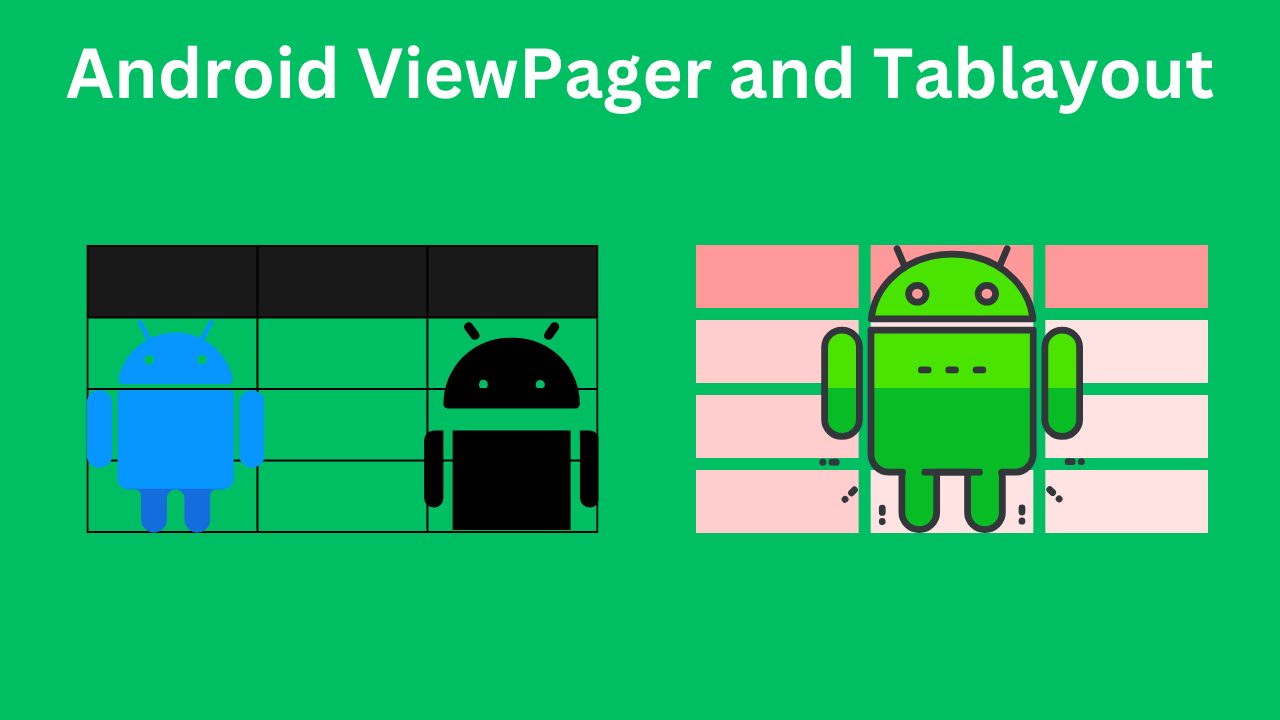Introduction
In modern Android development, using ViewPager and TabLayout together is a common way to create swipeable views with tabs. This combination benefits applications that require smooth navigation through different fragments or views, like social media apps, news readers, and more. This blog will guide you through the process of integrating ViewPager and TabLayout I am using Kotlin in an Android application.
Prerequisites
Before we start, ensure you have the following set up:
- Android Studio installed
- Basic knowledge of Kotlin and Android development
- A new Android project created
Step 1: Setting Up Dependencies
First, ensure you have the necessary dependencies in your build.gradle file. Add the following dependencies if they are not already included:
dependencies {
implementation "androidx.core:core-ktx:1.7.0"
implementation "androidx.appcompat:appcompat:1.4.0"
implementation "com.google.android.material:material:1.4.0"
implementation "androidx.constraintlayout:constraintlayout:2.1.2"
implementation "androidx.viewpager2:viewpager2:1.0.0"
implementation "androidx.fragment:fragment-ktx:1.4.0"
}
Step 2: Creating the Layouts
activity_main.xml
Create the main activity layout that includes the TabLayout and ViewPager2.
<RelativeLayout xmlns:android="http://schemas.android.com/apk/res/android"
xmlns:tools="http://schemas.android.com/tools"
android:layout_width="match_parent"
android:layout_height="match_parent"
tools:context=".MainActivity">
<com.google.android.material.tabs.TabLayout
android:id="@+id/tab_layout"
android:layout_width="match_parent"
android:layout_height="wrap_content"
android:layout_alignParentTop="true"
android:background="?attr/colorPrimary"
android:theme="@style/ThemeOverlay.AppCompat.Dark.ActionBar"/>
<androidx.viewpager2.widget.ViewPager2
android:id="@+id/view_pager"
android:layout_width="match_parent"
android:layout_height="match_parent"
android:layout_below="@id/tab_layout"/>
</RelativeLayout>
fragment_first.xml
Create a simple layout for the first fragment.
<RelativeLayout xmlns:android="http://schemas.android.com/apk/res/android"
android:layout_width="match_parent"
android:layout_height="match_parent"
android:padding="16dp">
<TextView
android:id="@+id/text_view"
android:layout_width="wrap_content"
android:layout_height="wrap_content"
android:text="First Fragment"
android:textSize="24sp"/>
</RelativeLayout>
fragment_second.xml
Create a simple layout for the second fragment.
<RelativeLayout xmlns:android="http://schemas.android.com/apk/res/android"
android:layout_width="match_parent"
android:layout_height="match_parent"
android:padding="16dp">
<TextView
android:id="@+id/text_view"
android:layout_width="wrap_content"
android:layout_height="wrap_content"
android:text="Second Fragment"
android:textSize="24sp"/>
</RelativeLayout>
Step 3: Creating the Fragments
Create two fragments, FirstFragment and SecondFragment, each with its layout.
FirstFragment.kt
package com.example.viewpagerdemo
import android.os.Bundle
import android.view.LayoutInflater
import android.view.View
import android.view.ViewGroup
import androidx.fragment.app.Fragment
class FirstFragment : Fragment() {
override fun onCreateView(
inflater: LayoutInflater, container: ViewGroup?,
savedInstanceState: Bundle?
): View? {
// Inflate the layout for this fragment
return inflater.inflate(R.layout.fragment_first, container, false)
}
}
SecondFragment.kt
package com.example.viewpagerdemo
import android.os.Bundle
import android.view.LayoutInflater
import android.view.View
import android.view.ViewGroup
import androidx.fragment.app.Fragment
class SecondFragment : Fragment() {
override fun onCreateView(
inflater: LayoutInflater, container: ViewGroup?,
savedInstanceState: Bundle?
): View? {
// Inflate the layout for this fragment
return inflater.inflate(R.layout.fragment_second, container, false)
}
}
Step 4: Setting Up the ViewPager Adapter
Create a ViewPagerAdapter class to handle the fragments in the ViewPager2.
ViewPagerAdapter.kt
package com.example.viewpagerdemo
import androidx.fragment.app.Fragment
import androidx.fragment.app.FragmentActivity
import androidx.viewpager2.adapter.FragmentStateAdapter
class ViewPagerAdapter(fragmentActivity: FragmentActivity) : FragmentStateAdapter(fragmentActivity) {
private val fragmentList = listOf(
FirstFragment(),
SecondFragment()
)
override fun getItemCount(): Int {
return fragmentList.size
}
override fun createFragment(position: Int): Fragment {
return fragmentList[position]
}
}
Step 5: Connecting the ViewPager and TabLayout
In your MainActivity, set up the ViewPager2 and TabLayout.
MainActivity.kt
package com.example.viewpagerdemo
import android.os.Bundle
import androidx.appcompat.app.AppCompatActivity
import com.google.android.material.tabs.TabLayoutMediator
import kotlinx.android.synthetic.main.activity_main.*
class MainActivity : AppCompatActivity() {
override fun onCreate(savedInstanceState: Bundle?) {
super.onCreate(savedInstanceState)
setContentView(R.layout.activity_main)
val viewPagerAdapter = ViewPagerAdapter(this)
view_pager.adapter = viewPagerAdapter
val tabTitles = listOf("Tab 1", "Tab 2")
TabLayoutMediator(tab_layout, view_pager) { tab, position ->
tab.text = tabTitles[position]
}.attach()
}
}
Step 6: Running the Application
Now, you can run your application. You should see a TabLayout with two tabs at the top and a ViewPager2 below it. Swiping left or right will switch between the fragments, and tapping on the tabs will navigate to the respective fragments.
Conclusion
In this blog, we’ve covered how to implement ViewPager and TabLayout in a Kotlin Android application. This combination is a powerful way to create a smooth and user-friendly navigation experience in your app. With ViewPager2 and TabLayout, you can easily add more fragments and customize the behavior to suit your needs.
Feel free to extend this tutorial by adding more fragments, customizing the layouts, or integrating additional features like data binding and view models to manage data more effectively.
This comprehensive guide should provide a solid foundation for implementing ViewPager and TabLayout in your Kotlin Android projects. Happy coding!

